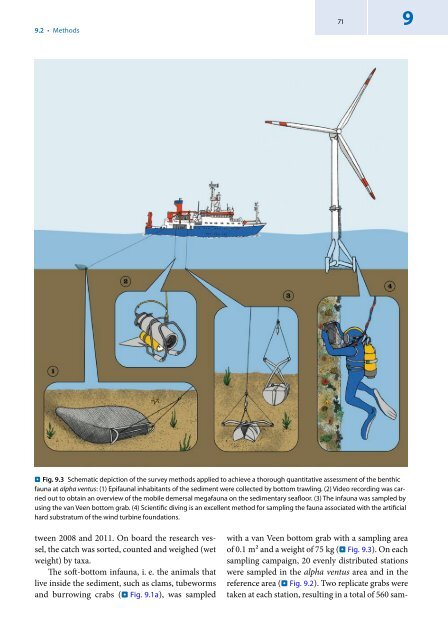- Page 1 and 2:
Federal Maritime and Hydrographic A
- Page 3 and 4:
Cover photos:alpha ventus offshore
- Page 5 and 6:
Federal Maritime and Hydrographic A
- Page 11 and 12:
XTable of Contents5.3 Learning from
- Page 13 and 14:
XIITable of Contents12.5.6 Estimati
- Page 15 and 16:
List of AuthorsDr. Sven AdlerSwedis
- Page 17 and 18:
List of AuthorsXVIIDr. Jochen Kraus
- Page 19 and 20:
List of AuthorsXIXKatharina Teschke
- Page 21 and 22:
3 1Current situation of offshoredev
- Page 23 and 24:
1.2 • Legal basis of offshore win
- Page 26 and 27:
8Chapter 1 • Current situation of
- Page 28 and 29:
11 2The Spatial Offshore GridPlan f
- Page 30:
2.2 • Accompanying Strategic Envi
- Page 34 and 35: 3.2 • Offshore challenges17 3..Fi
- Page 36 and 37: 3.3 • Operation of the offshore w
- Page 38 and 39: 3.7 • Outlook: alpha ventus as a
- Page 40 and 41: 3.7 • Outlook: alpha ventus as a
- Page 42 and 43: 26Chapter 4 • The RAVE research i
- Page 44 and 45: 28Chapter 4 • The RAVE research i
- Page 46 and 47: 31 5Accompanying ecologicalresearch
- Page 48 and 49: 5.1 • Environmentally compatible
- Page 50 and 51: 5.2 • Identifying environmental r
- Page 52 and 53: Literature37 5..Fig. 5.4 Colonisati
- Page 54 and 55: 40Chapter 6 • Conservation featur
- Page 56 and 57: 42Chapter 6 • Conservation featur
- Page 58 and 59: 44Chapter 6 • Conservation featur
- Page 60 and 61: 46Chapter 7 • Challenges, results
- Page 62 and 63: 48Chapter 7 • Challenges, results
- Page 64 and 65: 51 IIMain sectionChapter 8Chapter 9
- Page 66 and 67: 53 8Oceanographic andgeological res
- Page 68 and 69: 8.2 • Methods55 8. . Fig. 8.1 (a)
- Page 70 and 71: 8.2 • Methods57 8era, which then
- Page 72 and 73: 8.2 • Methods59 8..Fig. 8.6 Diagr
- Page 74 and 75: 8.3 • Results and discussion61 8.
- Page 76 and 77: 8.3 • Results and discussion63 8.
- Page 78 and 79: Literature65 8Information box: FINO
- Page 80 and 81: 68Chapter 9 • Increase of benthic
- Page 84 and 85: 72Chapter 9 • Increase of benthic
- Page 86 and 87: 74Chapter 9 • Increase of benthic
- Page 88 and 89: 76Chapter 9 • Increase of benthic
- Page 90 and 91: 78Chapter 9 • Increase of benthic
- Page 92 and 93: 80Chapter 9 • Increase of benthic
- Page 94 and 95: 83 10Effects of the alpha ventusoff
- Page 96 and 97: 10.1 • Introduction85 10..Fig. 10
- Page 98 and 99: 10.1 • Introduction87 10Near the
- Page 100 and 101: 10.2 • Methods89 10Hydroacoustic
- Page 102 and 103: 10.3 • Results and discussion91 1
- Page 104 and 105: Literature93 10of the average stoma
- Page 106 and 107: 95 11Effects of the alpha ventusoff
- Page 108 and 109: 11.1 • Introduction97 11. . Fig.
- Page 110 and 111: 11.2 • Methods99 11..Fig. 11.3 Ke
- Page 112 and 113: 11.3 • Results101 11..Fig. 11.4 D
- Page 114 and 115: 11.3 • Results103 11..Fig. 11.7 D
- Page 116 and 117: 11.3 • Results105 11..Fig. 11.10
- Page 118 and 119: 11.4 • Discussion107 11Generally,
- Page 120 and 121: Literature109 11..Fig. 11.13 One of
- Page 122 and 123: 111 12Of birds, blades and barriers
- Page 124 and 125: 12.3 • Bird migration over the Ge
- Page 126 and 127: 12.4 • Methods115 12oping dedicat
- Page 128 and 129: 12.4 • Methods117 12VARSVARS (Vis
- Page 130 and 131: 12.5 • Results and discussions119
- Page 132 and 133:
12.5 • Results and discussions121
- Page 134 and 135:
12.5 • Results and discussions123
- Page 136 and 137:
12.5 • Results and discussions125
- Page 138 and 139:
12.5 • Results and discussions127
- Page 140 and 141:
12.6 • Perspectivesferent viewing
- Page 142 and 143:
Literature131 12Cooper BA, Day RH,
- Page 144 and 145:
134Chapter 13 • Effects of alpha
- Page 146 and 147:
136Chapter 13 • Effects of alpha
- Page 148 and 149:
138Chapter 13 • Effects of alpha
- Page 150 and 151:
140Chapter 13 • Effects of alpha
- Page 152 and 153:
142Chapter 13 • Effects of alpha
- Page 154 and 155:
144Chapter 13 • Effects of alpha
- Page 159:
Literature149 13porpoises (Phocoena
- Page 162 and 163:
14.2 • Methods153 14. . Fig. 14.1
- Page 164 and 165:
14.1 • Introduction155 14..Table
- Page 166 and 167:
14.2 • Methods157 14..Fig. 14.4 T
- Page 168 and 169:
14.2 • Methods159 14..Fig. 14.6 T
- Page 170 and 171:
14.2 • Methods161 14..Fig. 14.10
- Page 172 and 173:
14.3 • Results163 14..Fig. 14.13
- Page 174 and 175:
14.3 • Results165 14..Fig. 14.15
- Page 176 and 177:
14.4 • Discussion167 1414.4 Discu
- Page 178 and 179:
Literature169 1420 km for harbor po
- Page 180 and 181:
172Chapter 15 • Underwater constr
- Page 182 and 183:
174Chapter 15 • Underwater constr
- Page 184 and 185:
176Chapter 15 • Underwater constr
- Page 186 and 187:
178Chapter 15 • Underwater constr
- Page 188 and 189:
180Chapter 15 • Underwater constr
- Page 190 and 191:
182Chapter 16 • Noise mitigation
- Page 192 and 193:
184Chapter 16 • Noise mitigation
- Page 194 and 195:
186Chapter 16 • Noise mitigation
- Page 196 and 197:
188Chapter 16 • Noise mitigation
- Page 198 and 199:
190Chapter 16 • Noise mitigation
- Page 200 and 201:
193 17Cumulative impactsof offshore
- Page 202 and 203:
17.4 • Underwater noise and marin
- Page 204 and 205:
Literature197 17..Fig. 17.2 State o
- Page 206 and 207:
199BackmatterLinks200Federal Mariti
- Page 208:
Links201North Sea and Baltic Sea Mo




